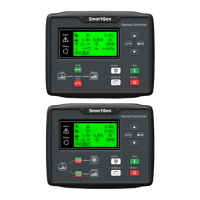12.2 STEP 2: MANUAL PARALLEL OPERATION OFF-LOAD
1)
Close breaker and parallel gensets manually, check that the units synchronization
parallel is smooth and steady and breaker close impulse current is not too high;
2)
After gensets parallel operation off load, check that there is no high circumfluence on
HGM6510 current screen;
3)
After gensets parallel operation off load, check if the output of active and reactive
power is equal to 0; if it is not, then check if there is power oscillation; if there is,
adjust the gain and stability values of HGM6510 controller, or adjust engine GOV or
generator AVR gain and stability potentiometer to avoid active and reactive power
oscillation; output is close to 0.
12.3 STEP 3: MANUAL PARALLEL OPERATION ON-LOAD
1)
Parallel the gensets manually, perform on-load test and check if active and reactive
power is evenly distributed between all the gensets;
2)
Parallel the gensets manually, perform ramp on-load test to see if there is high
overshoot or power oscillation during this period; if there is, regulate Load Rampx%/s
via PC software;
3)
Parallel the gensets and on-load manually, perform ramp off-load test to see if gen-
set breaker opens after reaching minimum load threshold (%);
4)
Parallel the gensets manually, perform impact load test and impact off-load test to
check if there is power oscillation.
12.4 STEP 4: FULLY AUTOMATIC PARALLEL OPERATION
When the controller is in auto mode, if “remote start on-load demand” is active, it will
carry out fully automatic parallel operation, start and stop according to the users’
requirement. There are 3 ways of automatic parallel operation:
1)
Start on-load demand: the module with the highest priority starts firstly. When load
exceeds the pre-set start maximum percentage, the second according to the priority
module will start the gen-set, synchronize and share load. When load falls lower than
the preset minimum stop percentage, after stop delay the second module breaker will
be open and the module will be cooled down and stopped.
2)
Start all sets initially: all the modules start at the same time; the first module to reach
load condition closes first; when other modules reach load condition, they
synchronize one by one. After that the modules monitors the load; If load value falls

